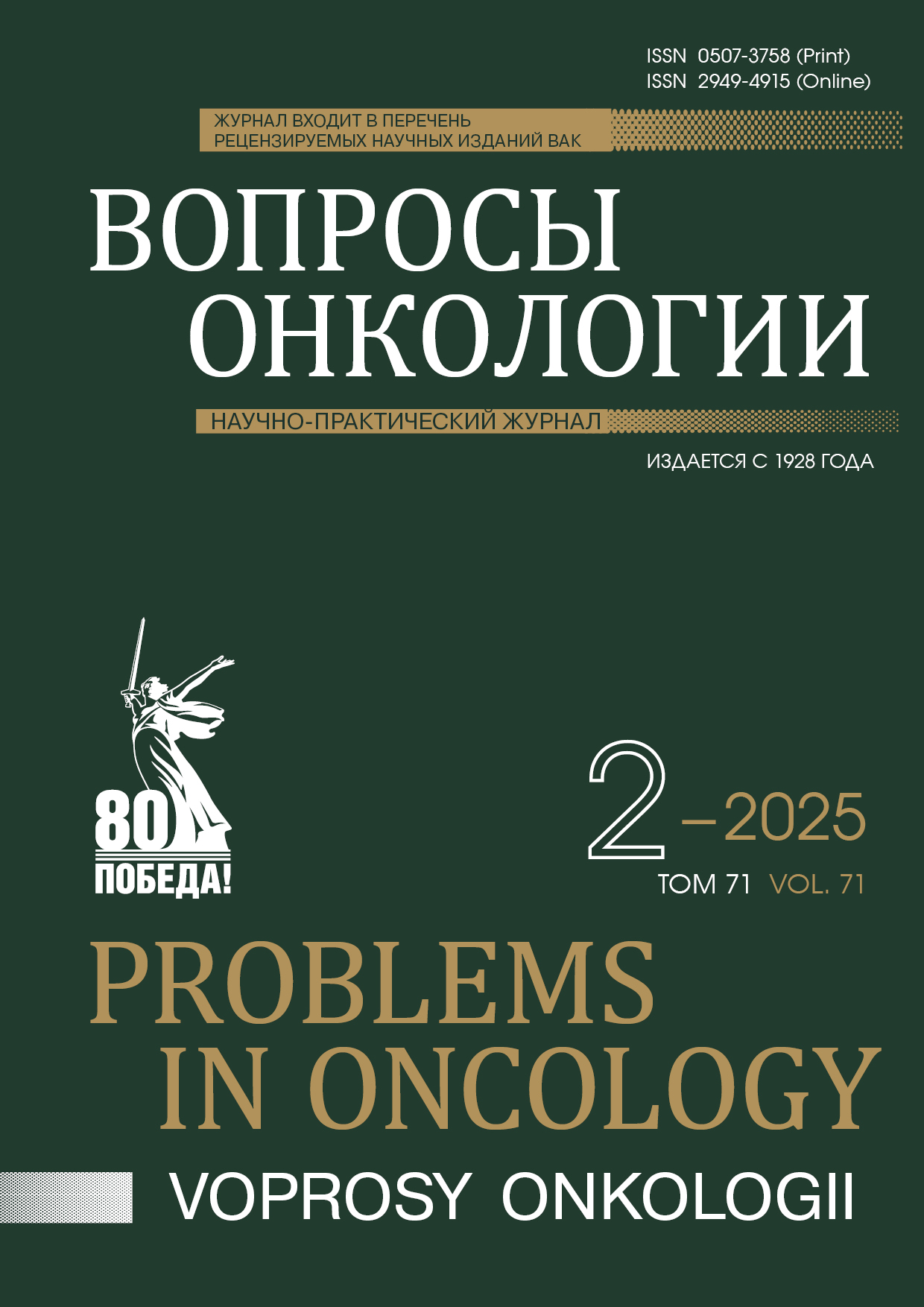Abstract
Introduction. To improve the differential diagnosis of chronic pseudotumor pancreatitis and pancreatic cancer, an immunohistochemical study was performed on surgical material from 20 patients with volumetric neoplasia of the pancreatic head who had previously undergone surgery. The Zinc-alpha-2-glycoprotein antibody was selected for this study as a marker of chronic pseudotumor pancreatitis. According to the results of the study with the Zinc-alpha-2-glycoprotein antibody on pancreatic tissue of patients with chronic pseudotumor pancreatitis, AZGP1 expression in acinar cells with strong staining was observed in all 12 (100 %) cases. While diffuse weak staining in the epithelium of tumor cells was observed in all pancreatic tissue samples with ductal adenocarcinoma.
Aim. To improve the diagnosis of patients with chronic pseudo-tumor pancreatitis by developing new diagnostic markers that contribute to the development and progression of chronic pancreatitis.
Materials and methods. The study included 20 patients with a volumetric neoplasm of the pancreatic head who had previously undergone surgery. The surgical procedures were performed in different volumes: Frey surgery — 8 (40.0 %), Beger surgery (Berne version) — 3 (15.0 %), Halperin resection of the pancreatic head — 1 (5.0 %), pancreatoduodenal resection — 8 (40.0 %).
Results. According to the results of the study with the Zinc-alpha-2-glycoprotein antibody on the pancreatic tissue of patients with chronic pseudotumor pancreatitis, in all 12 (100 %) cases AZGP1 was strongly stained in the acinar cells. Although the use of the AZGP1 antibody as a marker for chronic pseudotumorosis showed positive results, a study with a large amount of material is needed.
References
Siegel R.L., Wagle N.S., Cercek A., et al. Colorectal cancer statistics, 2023. CA Cancer J Clin. 2023; 73: 233-254.-DOI: https://doi.org/10.3322/caac.21772.-URL: https://acsjournals.onlinelibrary.wiley.com/doi/10.3322/caac.21772.
Zen Y., Deshpande V. Tumefactive inflammatory diseases of the pancreas. Am J Pathol. 2019; 189: 82-93.-DOI: https://doi.org/10.1016/j.ajpath.2018.05.022.-URL: https://www.clinicalkey.com/#!/content/playContent/1-s2.0-S0002944018302025?returnurl=null&referrer=null.
Chang W.I., Kim B.J., Lee J.K., et al. The clinical and radiological characteristics of focal mass-forming autoimmune pancreatitis: Comparison with chronic pancreatitis and pancreatic cancer. Pancreas. 2009; 38: 401-408.-DOI: https://doi.org/10.1097/MPA.0b013e31818d92c0.-URL: https://journals.lww.com/pancreasjournal/abstract/2009/05000/the_clinical_and_radiological_characteristics_of.8.aspx.
Schima W., Bohm G., Rosch C.S., et al. Mass-forming pancreatitis versus pancreatic ductal adenocarcinoma: CT and MR imaging for differentiation. Cancer Imaging. 2020; 20: 52.-DOI: https://doi.org/10.1186/s40644-020-00324-z. URL: https://pmc.ncbi.nlm.nih.gov/articles/PMC7376657/
Pasanen P.A., Eskelinen M., Partanen K., et al. Clinical value of serum tumour markers CEA, CA 50 and CA 242 in the distinction between malignant versus benign diseases causing jaundice and cholestasis; results from a prospective study. Anticancer Research.1992; 12: 1687-1693.-URL: https://www.researchgate.net/publication/221864306_Clinical_value_of_serum_CEA_CA19-9_CA72-4_and_CA242_in_the_diagnosis_and_prognosis_of_gastric_cancer.
Ge L., Pan B., Song F., et al. Comparing the diagnostic accuracy of five common tumor biomarkers and CA19-9 for pancreatic cancer: a protocol for a network meta-analysis of diagnostic test accuracy. BMJ Open. 2017; 7(12): e018175.-DOI: https://doi.org/10.1136/bmjopen-2017-018175.-URL: https://bmjopen.bmj.com/content/7/12/e018175.abstract.
Daamen L.A., Groot V.P., Heerkens H.D., et al. Systematic review on the role of serum tumor markers in the detection of recurrent pancreatic cancer. HPB (Oxford). 2018; 20: 297-304. -DOI: https://doi.org/10.1016/j.hpb.2017.11.009.-URL: https://www.hpbonline.org/article/S1365-182X(17)31157-7/fulltext.
Shen L., Qian Y., Wu W., et al. B7-H4 is a prognostic biomarker for poor survival in patients with pancreatic cancer. Hum Pathol. 2017; 66: 79-85.-DOI: https://doi.org/10.1016/j.humpath.2017.05.023.-URL: https://www.sciencedirect.com/science/article/abs/pii/S004681771730196X?via%3Dihub.
Lv Y., Wei Q., Yuan X., et al. Two sides of the pancreas: exocrine insufficiency is correlated with endocrine dysfunction in type 2 diabetes. Clinica Chimica Acta. 2021; 523: 81-6.-DOI: https://doi.org/10.1016/j.cca.2021.09.008.-URL: https://www.sciencedirect.com/science/article/abs/pii/S0009898121003193?via%3Dihub.
American Diabetes Association. 2. Classification and diagnosis of diabetes: standards of medical care in diabetes-2021. Diabetes Care. 2021; 44(Suppl 1): 15-33.-DOI: https://doi.org/10.2337/dc21-S002.-URL: https://diabetesjournals.org/care/article/44/Supplement_1/S15/30859/2-Classification-and-Diagnosis-of-Diabetes.
Bellin M.D., Whitcomb D.C., Abberbock J., et al. Patient and disease characteristics associated with the presence of diabetes mellitus in adults with chronic pancreatitis in the United States. Am J Gastroenterol. 2017; 112(9): 1457-1465.-DOI: https://doi.org/10.1038/ajg.2017.181.-URL: https://pmc.ncbi.nlm.nih.gov/articles/PMC6168293/.
Lv Y., Zhang J., Yang T., et al. Non-alcoholic fatty liver disease (NAFLD) is an independent risk factor for developing new-onset diabetes after acute pancreatitis: a multicenter retrospective cohort study in chinese population. Front Endocrinol (Lausanne). 2022; 13: 903731. DOI: https://doi.org/10.3389/fendo.2022.903731.-URL: https://europepmc.org/article/MED/35692404.
He S., Ryu J., Liu J., et al. LRG1 is an Adipokine that mediates obesity-induced hepatosteatosis and insulin resistance. J Clin Invest. 2021; 131(24): e148545.-DOI: https://doi.org/10.1172/JCI148545.-URL: https://www.jci.org/articles/view/148545.
Bing C., Trayhurn P. New insights into adipose tissue atrophy in cancer cachexia. Proc Nutr Soc. 2009; 68: 385-392.-DOI: https://doi.org/10.1017/S0029665109990267.-URL: https://www.cambridge.org/core/journals/proceedings-of-the-nutrition-society/article/new-insights-into-adipose-tissue-atrophy-in-cancer-cachexia/7FAAE56D157CFB5BC3F1A082255DF570.
Pearsey H.M., Henson J., Sargeant J.A., et al. Zinc-alpha2-glycoprotein, dysglycaemia and insulin resistance: a systematic review and meta-analysis. Rev Endocr Metab Disord. 2020; 21: 569-575.-DOI: https://doi.org/10.1007/s11154-020-09553-w.-URL: https://link.springer.com/article/10.1007/s11154-020-09553-w.
Bao Y., Bing C., Hunter L., et al. Zinc-alpha2-glycoprotein, a lipid mobilizing factor, is expressed and secreted by human (SGBS) adipocytes. FEBS Letters. 2005; 579: 41-47.-DOI: https://doi.org/10.1016/j.febslet.2004.11.042.-URL: https://www.sciencedirect.com/science/article/pii/S0014579304014218?via%3Dihub.
Welters I.D., Bing C., Ding C., et al. Circulating anti-inflammatory adipokines High Molecular Weight Adiponectin and Zinc-α2-glycoprotein (ZAG) are inhibited in early sepsis, but increase with clinical recovery: a pilot study. BMC Anesthesiology. 2014; 14: 124.-DOI: https://doi.org/10.1186/1471-2253-14-124.-URL: https://bmcanesthesiol.biomedcentral.com/articles/10.1186/1471-2253-14-124.

This work is licensed under a Creative Commons Attribution-NonCommercial-NoDerivatives 4.0 International License.
© АННМО «Вопросы онкологии», Copyright (c) 2025

